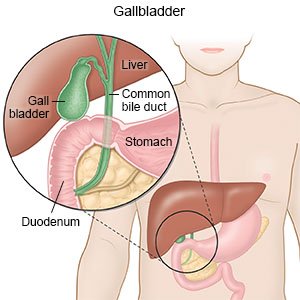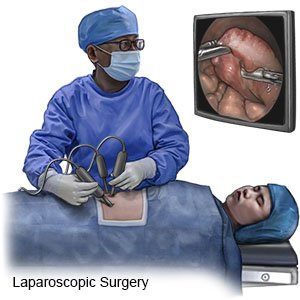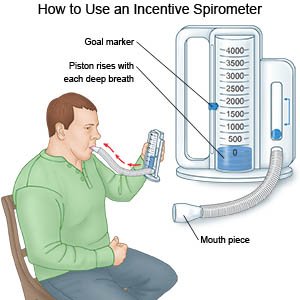Laparoscopic Cholecystectomy in Children
Medically reviewed by Drugs.com. Last updated on Aug 4, 2025.
AMBULATORY CARE:
What you need to know about laparoscopic cholecystectomy:
Laparoscopic cholecystectomy is surgery to remove gallstones and your child's gallbladder.
 |
How to help your child prepare for surgery:
- Your child's surgeon will tell you how to prepare. Tell him or her about all the medicines your child currently takes. The surgeon will tell you if your child needs to stop any medicine for surgery, and when to stop. He or she will tell you which medicines to give or not give your child on the day of surgery. You may be told not to let your child eat or drink anything after midnight on the day of surgery.
- Tell your child's surgeon about any allergies he or she has, including medicines and anesthesia. Your child may need blood or urine tests. He or she may also need x-rays, an ultrasound, or a CT scan. Tell your child's surgeon if he or she had an allergic reaction to contrast liquid.
What will happen during surgery:
- The surgeon will make 1 to 4 small incisions in your child's abdomen or belly button. He or she will insert small tools into the incisions. Your child's abdomen will be filled with carbon dioxide gas to make it swell. This helps the surgeon see the organs better and gives him or her room to move the tools around.

- Your child's surgeon will look for and remove gallstones in and around the gallbladder. He or she will carefully remove your child's gallbladder through one of the incisions. The carbon dioxide will be released from his or her abdomen. The incisions will be closed with stitches, medical glue, or adhesive strips, then covered with bandages.
What your child should expect after surgery:
Your child will be taken to a recovery room until he or she is fully awake. Healthcare providers will monitor your child closely for any problems. Providers will help him or her walk around to prevent blood clots. Your child may be able to go home later the same day or may stay in the hospital overnight.
- Pain, a sore throat, nausea, and vomiting are common after this surgery. These should get better within a few days. Your child may also have diarrhea that lasts up to a few months.
- Medicines may be given to prevent or treat pain, nausea, and vomiting. Medicines may also be given to prevent a bacterial infection. Blood thinners may be given to prevent blood clots. Your child may bleed or bruise more easily while he or she is taking blood thinners.
- Your child's surgeon will tell you when to remove the bandages covering the surgery area. He or she will tell you when it is okay for your child to start bathing. Your child may need to take showers instead of baths for a few days.
- Your child's surgeon will tell you when your child can return to school and regular daily activities. If your child is a teen, the surgeon will say when it is okay to drive or work.
- You will be shown how to care for the surgery area and check for signs of infection. You will also be told which foods to give your child in the days and weeks after surgery.
Risks of a laparoscopic cholecystectomy:
- Your child could bleed more than expected or get an infection. Nausea and vomiting are common after this surgery. Any carbon dioxide gas that remains in your child's body can cause neck and shoulder pain. Your child's gallbladder may leak bile into his or her abdomen during or after surgery. This can cause a severe infection or an abscess.
- Your child's surgeon may need to make a larger incision than expected during surgery. Your child may still have gallstones after surgery. He or she may need a different procedure to remove them. Your child's bile duct, bowel, or other organs could be damaged during surgery. This can be life-threatening.
Seek care immediately if:
- Your child has abdominal pain or bloating and vomiting.
- Your child cannot stop vomiting.
- Your child's bowel movements are bloody or black.
- Your child's abdomen is swollen, hard, and painful.
- Your child has a fever over 101°F (38°C) or chills.
Related medications
Call your child's doctor or surgeon if:
- Your child has pain or nausea that is not relieved by medicine.
- Your child has redness and swelling around his or her incisions.
- Your child has blood or pus coming from his or her incisions.
- Your child is constipated or has diarrhea.
- Your child's skin or eyes are yellow, or his or her bowel movements are pale.
- You have questions or concerns about your child's surgery, condition, or care.
Medicines:
Your child may need the following:
- NSAIDs , such as ibuprofen, help decrease swelling, pain, and fever. NSAIDs can cause stomach bleeding or kidney problems in certain people. If your child takes blood thinner medicine, always ask if NSAIDs are safe for him or her. Always read the medicine label and follow directions. Do not give these medicines to children younger than 6 months without direction from a healthcare provider.
- Prescription pain medicine may be given. Ask your healthcare provider how to take this medicine safely. Some prescription pain medicines contain acetaminophen. Do not take other medicines that contain acetaminophen without talking to your healthcare provider. Too much acetaminophen may cause liver damage. Prescription pain medicine may cause constipation. Ask your healthcare provider how to prevent or treat constipation.
- Do not give aspirin to children younger than 18 years. Your child could develop Reye syndrome if he or she has the flu or a fever and takes aspirin. Reye syndrome can cause life-threatening brain and liver damage. Check your child's medicine labels for aspirin or salicylates.
- Give your child's medicine as directed. Contact your child's healthcare provider if you think the medicine is not working as expected. Tell the provider if your child is allergic to any medicine. Keep a current list of the medicines, vitamins, and herbs your child takes. Include the amounts, and when, how, and why they are taken. Bring the list or the medicines in their containers to follow-up visits. Carry your child's medicine list with you in case of an emergency.
Have your child take deep breaths and cough as directed:
Your child's surgeon will tell you if your child should do this to lower the risk for a lung infection. Have your child take a deep breath and hold it for a few seconds. Then he or she should let the air out and cough strongly. Your child may be given an incentive spirometer to help him or her take deep breaths. Put the plastic piece in your child's mouth. Have him or her take a slow, deep breath. Then he or she should let the air out and cough. Repeat these steps 10 times every hour, or as directed.
 |
Care for the surgery area:
- Remove the bandages as directed. Your child's surgeon may tell you to remove the bandages the day after surgery.
- Keep the area clean and dry. Your child may take a shower the day after your surgery. Do not let your child take baths, swim, or use a hot tub until the surgeon says it is okay.
- Check for signs of infection each day. Check the area for swelling, red streaks, or pus. Tell your child's surgeon right away if you see any of these.
- Have your child hug a pillow against the surgery area before he or she sneezes or coughs. This will help prevent pain and protect the surgery area.
What to feed your child:
- Feed your child low-fat foods for 4 to 6 weeks while his or her body learns to digest fat without a gallbladder. Slowly increase the amount of fat he or she eats.
- Offer your child more liquids. Ask how much liquid to give your child and which liquids are best for him or her.
When your child can return to school and other activities:
- Have your child rest often and slowly increase his or her activity level each day. If an activity causes pain, your child should wait several days before he or she does that activity again.
- Do not let your teen drive for the first 24 hours after surgery. His or her surgeon will tell you when it is okay to drive after the first 24 hours. This is usually after your child has stopped taking narcotic pain medicine for a few days.
- Do not let your child lift anything heavier than 10 pounds until directed.
- Your child may return to school or other activities when pain is controlled and he or she feels comfortable. This is usually 1 to 2 weeks after surgery. Your child's surgeon can help create a return to sports plan, if needed.
Follow up with your child's doctor or surgeon as directed:
Write down your questions so you remember to ask them during your visits.
© Copyright Merative 2025 Information is for End User's use only and may not be sold, redistributed or otherwise used for commercial purposes.
The above information is an educational aid only. It is not intended as medical advice for individual conditions or treatments. Talk to your doctor, nurse or pharmacist before following any medical regimen to see if it is safe and effective for you.
Further information
Always consult your healthcare provider to ensure the information displayed on this page applies to your personal circumstances.
